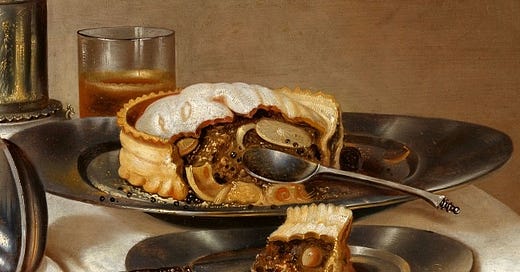The Hunting of the Flampet
On writing medieval historical fiction when you’re not actually a medievalist
As far as I can tell, the very first appearance of that most iconic of Arthurian images, the sword in the stone, is in the French writer Robert de Boron’s poem Merlin, which was written circa 1200.
Only a fragment of the actual poem survives; it’s mostly known from its later prose renderings:
And a-bove, in the myddill place of this ston, ther stode a styth of Iren that was largely half a fote of height, and thourgh this stithi was a swerde ficchid in to the ston.
(A styth is an anvil. So that was there from the start too.)
It’s a pretty humble and obscure debut for what would become an immortal Arthurian trope, and all credit to Robert if he did in fact come up with it from scratch. (I think Robert de Boron is, by a long ways, the most underrated of the great Arthurian architects, since he was also one of the early adopters of the Holy Grail story, immediately post-Chrétien, and the one who gave it its backstory as the cup from the Last Supper.)
Traditionally, the sword in the stone is part of a larger big-day-out set-piece in which Kay and Ector and Arthur, the three bumpkins from the Forest Sauvage, come to London for the tournament and goggle at the sights and sounds of the big city. This is familiar-enough material that when I rewrote it for The Bright Sword I did it from Sir Bedivere’s point of view instead to keep things interesting—Bedivere doesn’t know Arthur yet at that point, and is only peripherally interested in the sword in the stone. He’s got his own unrelated secret London business to attend to.
To complete the carnival atmosphere, I thought Bedivere should snack on some street food at the tournament, and for reasons I no longer I remember, based on sources I no longer remember, I decided that this food should be a flampet, which I understood to be a tart-like delicacy involving pork, figs, ale, cheese and pastry.
But since The Bright Sword came out, there has been some understandable skepticism on the topic of flampets—what they are and whether not they really exist. And it’s true that the historical record is thin. And I’ll also admit that there is something intrinsically hilarious and made-up-sounding about the word flampet. When you google it you get a fictional game from a Wild West role-playing community based on Red Dead Redemption 2. You also get spoonerisms of “pamflet,” and mis-typed transcripts of “Clampett” from Beverly Hillbillies episodes, and Disco Flampet, which I strongly encourage you to use as the soundtrack for this post.
You don’t get a medieval food though. It doesn’t take much to tip me over into self-doubt, and I started to wonder if I’d just made up the flampet and then forgot about it. So I set about trying to authenticate it. Time to hit the books! Google Books, that is.
(What I really need is access to JSTOR, and I can in theory get it through my wife, but I have to bug her to authenticate me every time, a ritual that we’re both tired of.)
The first reference to flampets in Google Books is now, maybe predictably, The Bright Sword, which for obvious reasons isn’t going to help us much. Further down comes a recent book called The Plantagenet Socialite which describes a flampet as “pork, figs boiled in small ale and fried cheese baked in a pastry coffin.” Done! You don’t get much more medieval than a pastry coffin.
But the author of The Plantagenet Socialite is not an academic, so not an unimpeachable source; for all I know we could both be perpetuating the same false flampet mythology, unknowingly doing the work of the shadow flampet syndicate. What I really needed was a primary source from the period.
So I ventured further. The word flampet crops up for no reason in all kinds of unrelated, non-culinary contexts—an insurance yearbook, a statistical bulletin, an 18th-century travel narrative involving a Mr. Flampet where Google accidentally scanned someone’s hand:
I fell down the flampet rabbit hole, faster and faster. A 19th-century history reprints a catalog of dishes from a 15th century marriage feast that includes the following:
Aha! But what is a flampett-with-two-t’s? The author didn’t know:
(I do hope leich brayne isn’t leech brains. I know medieval people would eat anything but please. Have some self-respect.)
There’s a history book from 1914 called The Reign of Henry the Fifth: 1413-1415, by James Hamilton Wylie and William Templeton Waugh, no doubt beloved of schoolchildren everywhere, that has this from a description of Henry’s coronation feast:
There it is again: pork, figs, ale, cheese, and that coffin. Again not a primary source, but a properly academic one, and it comes with a footnote that sends us back to two older sources. One is Gregory’s Chronicle, a 15th century account of life in London. But I consulted several digitized versions, and all I found was a passing reference to a dish called a flampayne.
The second source cited by Wylie and Waugh is The Forme of Cury, one of the oldest surviving English cookbooks, circa 1390, which was apparently compiled Richard II’s chef, and if that’s not credibility I don’t know what is. Searching the Forme for flampets yields nothing; there are two passing references to flampetts, but no further details.
But the index suggests two alternate spellings for flampet, namely flaunpett and flaumpeyn. A search for flaunpett also gives us nothing—useless, I spit on you—but with flaumpeyn we arrive at our grail, an actual contemporary recipe:
FOR TO MAKE FLAUMPEYNS. C. XIII.
Take clene pork and boile it tendre. þenne hewe it small and bray it smal in a morter. take fyges and boile hem tendre in smale ale. and bray hem and tendre chese þerwith. þenne waisthe hem in water & þene lyes [1] hem alle togider wit Ayrenn, þenne take powdour of pepper. or els powdour marchannt & ayrenn and a porcioun of safroun and salt. þenne take blank sugur. eyrenn & flour & make a past wit a roller, þene make þerof smale pelettes [2]. & fry hem broun in clene grece & set hem asyde. þenne make of þat ooþer deel [3] of þat past long coffyns [4] & do þat comade [5] þerin. and close hem faire with a countoer [6], & pynche hem smale about. þanne kyt aboue foure oþer sex wayes, þanne take euy [7] of þat kuttyng up, & þenne colour it wit zolkes of Ayrenn, and plannt hem thick, into the flaumpeyns above þat þou kuttest hem & set hem in an ovene and lat hem bake eselich [8]. and þanne serue hem forth.
Beautiful. Detailed, primary and complete with sex wayes. Fit for a king.
I still can’t honestly tell if a flaumpeyn is the kind of hand-meal you could eat walking around at a grand tournament for a dead king; I suspect not, which makes its role in The Bright Sword at least a little suspect. After-action googling of flaumpeyn yields an OED entry for flampoint: “a pie or tart ornamented with pointed pieces of pastry.” Well, that could’ve saved me a lot of trouble.
I also still don’t understand how we got from there to flampet, which now seems like an egregiously modern spelling. But it’s good enough. Sir Bedivere, you may have your flampet back. Now eat up, and go find your king.










So according to chatbot: "leich brayn" could potentially refer to a dish combining the textures of a leich (a thickened or sliced sweet) with brain, though this would be quite unusual as a combination.-yes indeed chatbot,yes indeed. 🤢🤮
So the pork, cheese, and figs were in eyren which is Middle English for eggs. Which means that it’s technically a quiche. Implying that there is an English word for quiche (depending on whether a coffin of pastry implies a lid on the pie or not). Thank you for this marvellous word!
You can read (but not download) 99 papers a month on JSTOR if you sign up for a free account.